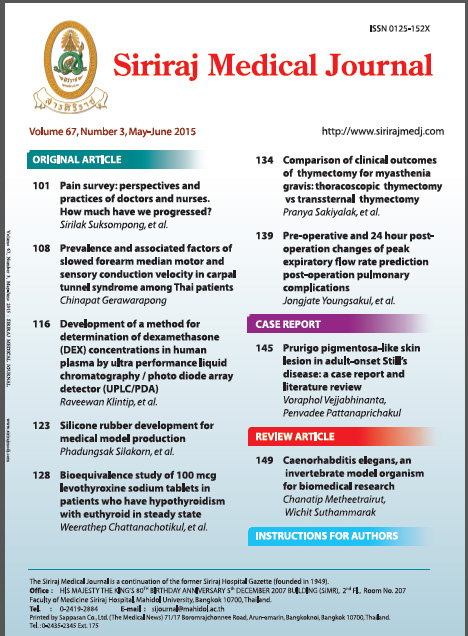Development of a Method for Determination of Dexamethasone (DEX) Concentrations in Human Plasma by Ultra Performance Liquid Chromatography / Photo Diode Array Detector (UPLC/PDA)
Abstract
Objective: At present, Cushing's syndrome (CS) is diagnosed by measuring cortisol levels and the dexamethasone suppression test. However, the false positive results were found in patients who have stress or lack of drug compliance. Several studies reported a relationship between cortisol and dexamethasone concentration in plasma and measurement of both has proved most useful for identifying patients’ diagnoses. Although, many highly sensitive and specific methods have been reported, the method which was suitable for routine analysis was required. In this study, we aimed to develop a cheaper UPLC-PDA method and to fully validate it for determination of dexamethasone in human plasma.
Methods: Chromatographic separation was carried out by the ACQUITY UPLC™ BEH Shield RP, 1.7 µm (100 x 2.1 mm.I.D.) with mobile phase consisting of 0.05% Trifluoroacetic acid / Acetonitrile in gradient program. The Photodiode Array (PDA) Detector was set at 240.2 nm.
Results: The run time was 6 min, 2.40 min for dexamethasone and 3.67 min for prednisolone (IS). The limit of quantification was 2.0 ng/mL. The standard curves are in the range 2-60 ng/mL with good linearity (r2 > 0.9975). The method was acceptable in terms of selectivity, accuracy, precision, stability and matrix effect. The measured dexamethasone concentrations ranged from 2.0 - 8.2 ng/mL (5.12 - 21.03 nmol/L).
Conclusion: A highly rapid, sensitive, accurate and reproducible UPLC-PDA method was developed and fully validated for the determination of dexamethasone in plasma. This method was successfully applied to routine measurement of dexamethasone concentration in plasma of patients after the low-dose dexamethasone suppression test.
Keywords: UPLC/PDA, dexamethasone, Cushing’s syndrome
Downloads
Published
How to Cite
Issue
Section
License
Authors who publish with this journal agree to the following conditions:
Copyright Transfer
In submitting a manuscript, the authors acknowledge that the work will become the copyrighted property of Siriraj Medical Journal upon publication.
License
Articles are licensed under a Creative Commons Attribution-NonCommercial-NoDerivatives 4.0 International License (CC BY-NC-ND 4.0). This license allows for the sharing of the work for non-commercial purposes with proper attribution to the authors and the journal. However, it does not permit modifications or the creation of derivative works.
Sharing and Access
Authors are encouraged to share their article on their personal or institutional websites and through other non-commercial platforms. Doing so can increase readership and citations.










